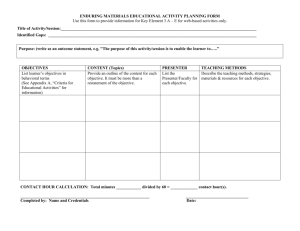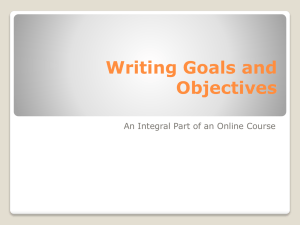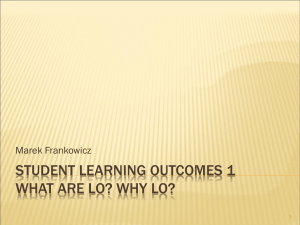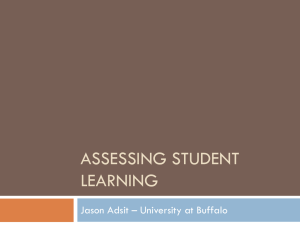RubricForEvaluatingCourseLearningObjectives102412sw
advertisement
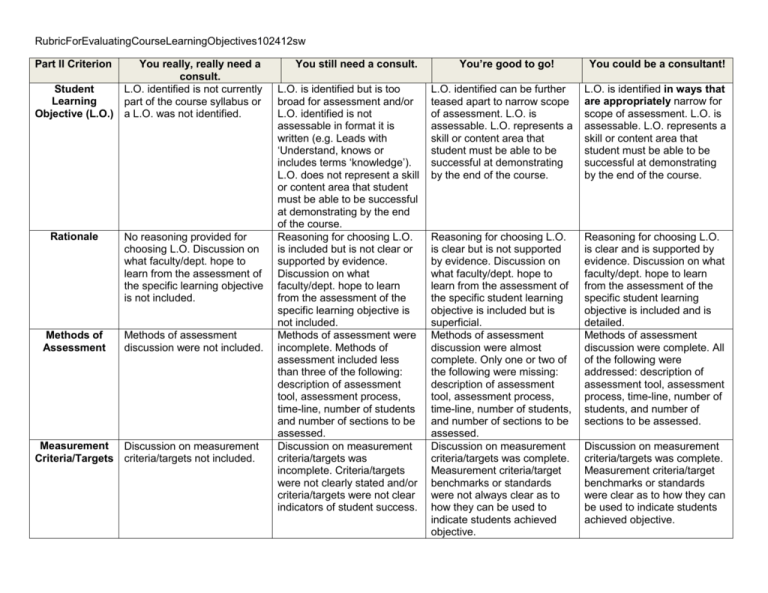
RubricForEvaluatingCourseLearningObjectives102412sw Part II Criterion You really, really need a consult. Student L.O. identified is not currently Learning part of the course syllabus or Objective (L.O.) a L.O. was not identified. Rationale No reasoning provided for choosing L.O. Discussion on what faculty/dept. hope to learn from the assessment of the specific learning objective is not included. Methods of Assessment Methods of assessment discussion were not included. Measurement Discussion on measurement Criteria/Targets criteria/targets not included. You still need a consult. L.O. is identified but is too broad for assessment and/or L.O. identified is not assessable in format it is written (e.g. Leads with ‘Understand, knows or includes terms ‘knowledge’). L.O. does not represent a skill or content area that student must be able to be successful at demonstrating by the end of the course. Reasoning for choosing L.O. is included but is not clear or supported by evidence. Discussion on what faculty/dept. hope to learn from the assessment of the specific learning objective is not included. Methods of assessment were incomplete. Methods of assessment included less than three of the following: description of assessment tool, assessment process, time-line, number of students and number of sections to be assessed. Discussion on measurement criteria/targets was incomplete. Criteria/targets were not clearly stated and/or criteria/targets were not clear indicators of student success. You’re good to go! You could be a consultant! L.O. identified can be further teased apart to narrow scope of assessment. L.O. is assessable. L.O. represents a skill or content area that student must be able to be successful at demonstrating by the end of the course. L.O. is identified in ways that are appropriately narrow for scope of assessment. L.O. is assessable. L.O. represents a skill or content area that student must be able to be successful at demonstrating by the end of the course. Reasoning for choosing L.O. is clear but is not supported by evidence. Discussion on what faculty/dept. hope to learn from the assessment of the specific student learning objective is included but is superficial. Methods of assessment discussion were almost complete. Only one or two of the following were missing: description of assessment tool, assessment process, time-line, number of students, and number of sections to be assessed. Discussion on measurement criteria/targets was complete. Measurement criteria/target benchmarks or standards were not always clear as to how they can be used to indicate students achieved objective. Reasoning for choosing L.O. is clear and is supported by evidence. Discussion on what faculty/dept. hope to learn from the assessment of the specific student learning objective is included and is detailed. Methods of assessment discussion were complete. All of the following were addressed: description of assessment tool, assessment process, time-line, number of students, and number of sections to be assessed. Discussion on measurement criteria/targets was complete. Measurement criteria/target benchmarks or standards were clear as to how they can be used to indicate students achieved objective. Student L.O. identified is not currently Learning part of the course syllabus or Objective (L.O.) a L.O. was not identified. L.O. is identified but is too broad for assessment and/or L.O. identified is not assessable in format it is written (e.g. Leads with ‘Understand, knows or includes terms ‘knowledge’). L.O. does not represent a skill or content area that student must be able to be successful at demonstrating by the end of the course. L.O. identified can be further teased apart to narrow scope of assessment. L.O. is assessable. L.O. represents a skill or content area that student must be able to be successful at demonstrating by the end of the course. L.O. is identified in ways that are appropriately narrow for scope of assessment. L.O. is assessable. L.O. represents a skill or content area that student must be able to be successful at demonstrating by the end of the course. Module 4: Developing Goals and Objectives Instructor’s Notes Rubric: Guidelines for Evaluating Behavioral Objectives This is an example of how to create clear guidelines for evaluation and grading of behavioral objectives. What counts? Competent Work Common Mistake Needs to be revised Missed the Point Objectives are measurable Objectives are measurable and include specific information about what the student will be able to do,e.g. how well, how many, to what degree Objectives are too general and don't include specific information on what the student will be able to do, e.g.. how well, how many, to what degree Objective are not measurable Objectives are not universally measurable and do not include what the student will be able to do Objectives require high levels of cognition Objectives reflect high levels of cognition according to Bloom's Taxonomy All the objectives require low levels of cognition such as "demonstrates understanding,"or "identifies" Objectives should include at least one of the verbs in the levels 3-6 of Bloom's Taxonomy Objectives don't use verbs to describe what the student will be able to do The learning objectives should be achievable The objectives listed are realistic given the time and level of the target audience There are too many objectives Objectives are too difficult Objectives don't use verbs to describe what the student will be able to do Are the goals The leaning The learning objectives The learner can't The learner doesn't want to Objectives don't describe what the student will be able to do of interest to the learner? objectives are of interest to the learner don't make the intrinsic and external motivation clear to the learner understand the learning objectives complete the tasks in the learning objectives • Compare and contrast learning objectives vs. learning goals. • List the 3 parts of the “ideal” learning objective. • Write learning objectives that contain a measurable verb and communicate clearly to the student. • Develop learning objectives which demonstrate Bloom’s higher levels of thinking. A learning objective or behavioral objective, if you prefer, is much more specific than a goal. According to Mager, the ideal learning objective has 3 parts: 1. A measurable verb 2. The important condition (if any) under which the performance is to occur and 3. The criterion of acceptable performance. • Consistent with the goals of the curriculum • Clearly stated • Clearly measurable • Realistic and doable • Appropriate for the level of the learner • Worthy (Important stuff) BLOOM'S TAXONOMY OF LEARNING OUTCOMES Knowledge is defined as the remembering of previously learned material represents the lowest level of learning involves recalling or reciting: facts, observations, or definitions Comprehension is defined as the ability to grasp the meaning of material represents the lowest level of understanding involves explaining, interpreting, or translating Application refers to the ability to use learned material in new and concrete situations requires higher level of understanding than comprehension involves applying: rules, methods, laws, principles Analysis refers to the ability to break down material into its component parts so that its organizational structure may be understood represents a higher level than previous categories because of requirement of understanding of both the content and structural form of the material involves analyzing relationships, distinguishing between facts and inferences, evaluating data relevance Synthesis refers to the ability to put parts together to form a new whole represents creative behaviors, with emphasis on the formulation of new patterns or structures involves proposing plans, writing speeches, creating classification schema Evaluation is concerned with the ability to judge the value of material for a given purpose represents highest level because of inclusion of elements of all other categories plus conscious value judgments based on criteria involves judging logical consistency, adequacy of data support for conclusions Should the LO be included in this course? Is the LO appropriate for the learner’s level of ability (cognitive, affective, psychomotor)? Does the LO clearly articulate what the student must do to demonstrate competence? Does the verb used in the LO reflect an observable behavior that can be measured? Has an assessment method been created that will validate mastery of the LO? CHECKLIST FOR EVALUATING LEARNING OBJECTIVES 1. The learning objective __ addresses students. __ contains an action verb for the appropriate domain and level of learning. __ specifies the circumstances (optional). __ stipulates the criteria or standard for performance (optional). 2. The learning objective is __ specific __ measurable __ action-oriented __ appropriate for the domain and level of learning __ aligned with program objectives and/or accrediting standards __ realistic __ time-framed What are the 2 qualities of a useful objective? Useful objectives are those that clearly communicate an intended instructional outcome. Objectives always state a performance, describing what the learner will be doing when demonstrating mastery of the objective. Useful objectives have two components: 1. Performance – An objective always states what a learner is expected to do in order to demonstrate mastery of the objective. 2. Criterion – If possible, the objective describes the criterion of acceptable performance by describing how well the learner must perform in order to be considered acceptable. 4 Elements of a Measurable Objective: WHO will do WHAT and HOW MUCH (HOW WELL) by WHEN How can objectives help students engage with the content at a higher order of thinking? When writing objectives, you need to consider not only the content that is being taught but the cognitive skills you want students to utilize. Do you want students to simply be able to recall information or do you want them to explain, interpret, analyze or evaluate information? By asking for certain types of performance in your objectives, you can help students use higher order cognitive skills. Bloom’s taxonomy identifies verbs that can require student to use a variety of cognitive skills. The taxonomy is a great tool that can be used to create objectives (See Appendix B for Bloom’s Taxonomy). Summary: Goals are broad, generalized statements about what is to be learned. Think of them as a target to be reached or “hit”. Learning objectives are specific, measurable, short-term, observable student behaviors. Checklist for Evaluating Learning Objectives: 1. Does the objective describe an intended instructional outcome? 2. Is the intended outcome described in terms of student performance? 3. Does the objective describe how well the student must perform in order to be considered acceptable? An example would be that you would like the student to be able to explain the information, but the student will not be held responsible for being able to compare and contrast it to other information. What are common problems instructors encounter when writing objectives? 1. False objectives. These statements often look and sound like objectives but they contain no performances. Rather than performances, these objectives often describe abstract states of being (appreciating, valuing, and understanding). “Students will have a thorough understanding of biostatistics.” 2. Practice exercises. These statements describe a classroom activity or exercise rather than an instructional outcome. “Students will be able to discuss patient case histories.” 3. Instructor performance. These statements describe what the instructor is expected to do rather than what the students are expected to do. “The instructor will help students recognize…” 4. False Criteria. Sometimes otherwise useful objectives will include criteria that include little or no information about the quality of performance. Make sure that criteria say something about the quality of individual student performance and provide a real standard. The functions of objectives are to: • Provide direction and parameters for a learning session • Direct choice of content • Direct choice of assignments • Suggest effective instructional methods • Communicates purpose to others involved (learners, administrators, curriculum oversite committees) • Drive evaluation methods • Enable evaluation, thereby demonstrating effectiveness of curriculum Measurable objectives allow for refinement of curricular content and guide selection of instructional and assessment methods. Objectives must be measurable and specific in order to determine if the goal was achieved. More specifically, an objective is a description of a performance that learners should be able to demonstrate in order to be considered competent in a given area. An objective describes the intended instructional result, not the process of instruction. In other words, learner achievement describes what a student or group of students will know or do as a result of instruction. Useful objectives are those that clearly communicate an intended instructional outcome. Objectives always state a performance, describing what the learner will be doing when demonstrating mastery of the objective. Useful objectives have two components: 1. Performance – An objective always states what a learner is expected to do in order to demonstrate mastery of the objective. 2. Criterion – If possible, the objective describes the criterion of acceptable performance by describing how well the learner must perform in order to be considered acceptable. 4 Elements of a Measurable Objective: WHO will do WHAT and HOW MUCH (HOW WELL) by WHEN How can objectives help students engage with the content at a higher order of thinking? When writing objectives, you need to consider not only the content that is being taught but the cognitive skills you want students to utilize. Do you want students to simply be able to recall information or do you want them to explain, interpret, analyze or evaluate information? By asking for certain types of performance in your objectives, you can help students use higher order cognitive skills. Bloom’s taxonomy identifies verbs that can require student to use a variety of cognitive skills. The taxonomy is a great tool that can be used to create objectives (See Appendix B for Bloom’s Taxonomy). Checklist for Evaluating Learning Objectives: 1. Does the objective describe an intended instructional outcome? 2. Is the intended outcome described in terms of student performance? 3. Does the objective describe how well the student must perform in order to be considered acceptable? An example would be that you would like the student to be able to explain the information, but the student will not be held responsible for being able to compare and contrast it to other information. What are common problems instructors encounter when writing objectives? 1. False objectives. These statements often look and sound like objectives but they contain no performances. Rather than performances, these objectives often describe abstract states of being (appreciating, valuing, and understanding). “Students will have a thorough understanding of biostatistics.” 2. Practice exercises. These statements describe a classroom activity or exercise rather than an instructional outcome. “Students will be able to discuss patient case histories.” 3. Instructor performance. These statements describe what the instructor is expected to do rather than what the students are expected to do. “The instructor will help students recognize…” 4. False Criteria. Sometimes otherwise useful objectives will include criteria that include little or no information about the quality of performance. Make sure that criteria say something about the quality of individual student performance and provide a real standard. http://www.roundworldmedia.com/cvc/module4/notes4.html http://www.roundworldmedia.com/cgi-bin/cgiwrap/project2/wizard.cgi http://www.roundworldmedia.com/cvc/module4/4nrubric.htm Behavioral Objectives Checklist Do each of the objectives describe what the student will have done when they complete the course? Categorize the verbs in the objectives according to Bloom’s taxonomy? Does at least one objective fall into categories three through six? Application (3) Analysis (4) Synthesis (5) Evaluation (6) Do your objectives describe "to what degree" or "how much" or "how well" a student must demonstrate the skill or knowledge? What is the most exciting part of the skill you are teaching? Can you incorporate or emphasize that element more in your goals and objectives? If you have more than fifteen objectives you probably need to cut back on the content of your course. Review and compare your goals and objectives with those of a courses you have evaluated. ß Compare your goals and objectives with those of courses similar to yours. What can be improved in the other course’s goals and objectives? Do your goals and objectives need revision? Questions for Formulating Significant Learning Goals "A year (or more) after this course is over, I want and hope that students will .” Foundational Knowledge • What key information (e.g., facts, terms, formulae, concepts, principles, relationships, etc.) is/are important for students to understand and remember in the future? • What key ideas (or perspectives) are important for students to understand in this course? Application Goals • What kinds of thinking are important for students to learn? • Critical thinking, in which students analyze and evaluate • Creative thinking, in which students imagine and create • Practical thinking, in which students solve problems and make decisions • What important skills do students need to gain? • Do students need to learn how to manage complex projects? Integration Goals • What connections (similarities and interactions) should students recognize and make…: • Among ideas within this course? • Among the information, ideas, and perspectives in this course and those in other courses or areas? • Among material in this course and the students' own personal, social, and/or work life? Human Dimensions Goals • What could or should students learn about themselves? • What could or should students learn about understanding others and/or interacting with them? Caring Goals • What changes/values do you hope students will adopt? Feelings? Interests? Ideas? "Learning-How-to-Learn" Goals • What would you like for students to learn about: • how to be good students in a course like this? • how to learn about this particular subject? • how to become a self-directed learner of this subject, i.e., having a learning agenda of what they need/want to learn, and a plan for learning it? . Learning Goals and Feedback & Assessment Issues to address include: • How well do your assessment procedures address the full range of learning goals? • Is the feedback giving students information about all the learning goals? • Do the learning goals include helping the students learn how to assess their own performance?
